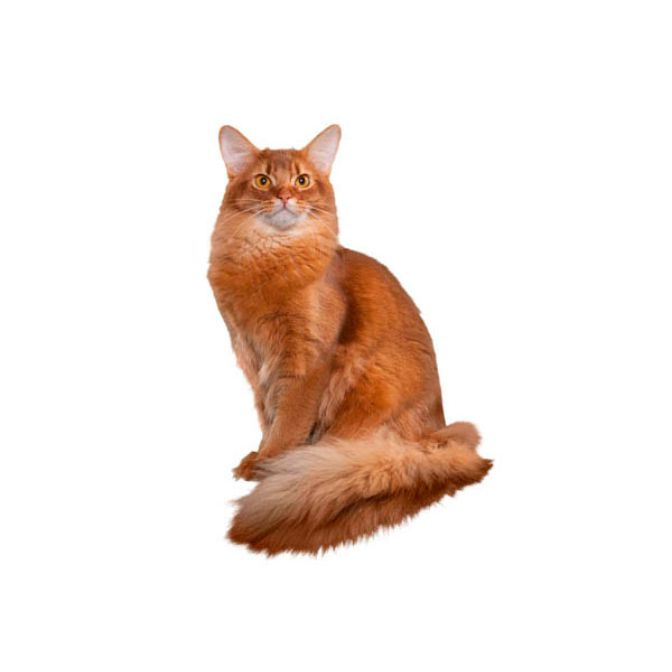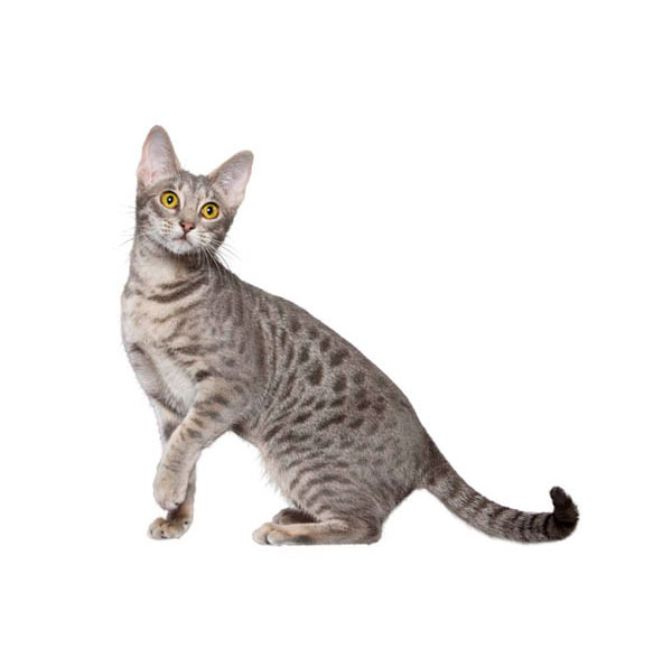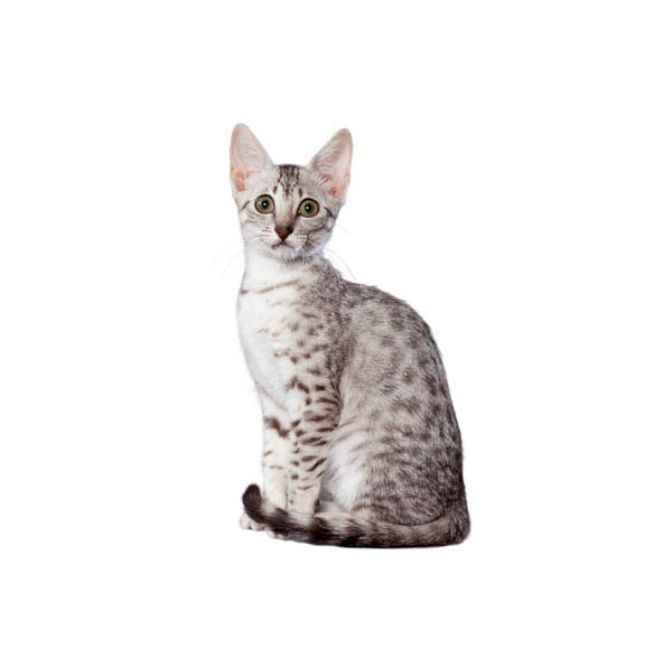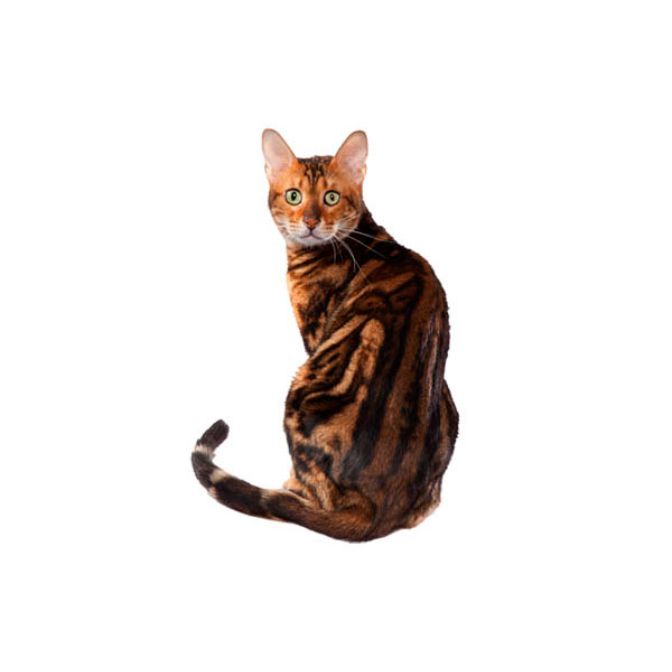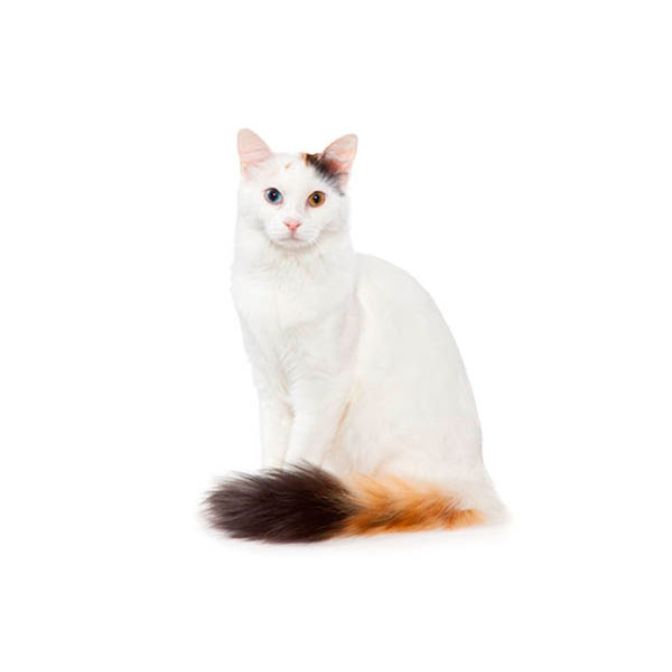Somali
Strikingly beautiful, the Somali looks like a small wild fox with her full bushy tail and britches, large ears and dramatically ticked coat. This highly intelligent feline is known to open cupboards and fetch toys. The Somali loves attention and affection. The breed also is known for loving to play and having a zest for life. Highly adaptable, the Somali adjusts easily to new people and situations.
Medium To Large
Medium
High
4 to 7kg.
Ruddy, red, blue, fawn
The Somali is highly intelligent. They are good natured and playful and enjoy games and toys. They may be slightly more shy than their Abyssinian cousins but enjoy human company. They are active and enjoy access to outdoor exercise but care needs to be taken that these attractive cats don’t wander off or be stolen.
A secure garden is ideal for them or, if this is not possible, they will adapt to an indoor life if plenty of toys and scratching posts are provided.
The Somali is of medium build and foreign type. The head forms a medium wedge with gentle contours. In profile the nose has a definite but slight nose break and a firm chin. The forehead should be high with good width between the ears.
The ears are set wide apart but on the top of the head. They are large and broad based and tufted. The eyes are almond shaped and set well apart. They are large and expressive. Dark surrounds emphasise the eye with circled by paler spectacles.
Short dark lines appear at both sides of the eye, the inner lines are vertical and the outer ones point towards the ear. The eyes are amber, hazel or green, the deeper the shade the better. The body is of medium size; firm, lithe and well muscled. The legs are long and have oval tufted paws. The tail is long and tapering. The Somali comes in 28 different colours.
12 to 14 years.
The coat is of medium length. The soft and fine hair is dense but lies flat against the body. Mature adults will have a ruff and full breeches but this will not be evident in kittens. As in the Abyssinian ticking is most important. On each hair there should be at least three bands of ticking giving six contrasting colour sections from base to tip. The ticking is slow to develop in kittens but there should be some evidence of ticking on the shoulders.
The ear tips, tufts, facial markings, toe tufts, heels, top and tip of tail are the same colour as the ticking. It is preferable for there to be darker shading along the spine and top of the tail. The chest, belly, under tail and inside of the legs are the colour of the base hair. The Somali comes in a choice of twenty-eight colours.
'Usual' - A rich golden brown with an apricot base coat ticked with black. The nose leather is tile red and the paw pads are black or brown.
'Sorrel' - A rich copper colour with an apricot base ticked with cinnamon.The nose leather and paw pads are pink.
'Chocolate' - A vivid coppery brown with an apricot base ticked with dark chocolate. The nose leather is pinkish chocolate and the paw pads are chocolate.
'Blue' - A soft blue with an oatmeal or mushroom base coat ticked with any shade of blue. The nose leather and paw pads are blue.
'Lilac' - A warm dove grey with an oatmeal or mushroom base coat ticked with lilac. The nose leather and paw pads are mauvish pink.
'Fawn' - A warm fawn with a pale oatmeal or mushroom base coat ticked with fawn. The nose leather is pink and the paw pads are mauvish pink.
'Red' - Bright red ticking over a paler red base coat. The nose leather and paw pads are bright pink.
'Cream' - Rich cream ticking with a paler cream base coat. The nose leather is creamy pink and the paw pads are pink.
Tortie Colours - In the tortie colours the distribution of colour is random. Solid feet are not allowed. The ticking, ear tips, tufts, facial markings, toe tufts, heels and top and tip of tail are a mingling of the standard ticking colour and red or cream. The chest, belly, under tail, inside of legs, and breeches are a mingling of the standard base coat colour and either red or cream.
'Usual Tortie' - The ticking is mingled black and bright red and the base coat is mingled apricot and red.
'Sorrel Tortie' - The ticking is mingled cinnamon and bright red and the base coat is mingled apricot and red.
'Chocolate Tortie' - The ticking is mingled dark chocolate and red and the base coat is mingled apricot and red.
'Blue Tortie' - The ticking is mingled blue and cream and the base coat is pale cream.
'Lilac Tortie' - The ticking is mingled lilac and cream and the base coat is pale cream.
'Fawn Tortie' - The ticking is mingled fawn and cream and the base coat is pale cream.
Silver Somali - The base coat of this variety is silvery white giving a lustrous silver sheen. The ticking, ear tips, tufts, facial markings, toe tufts, heels and top and tip of tail are the same as the non-silver of the appropriate colour. The colours available in the silver variety are: - usual, sorrel, chocolate, blue, lilac, fawn, red, cream and all the tortie colours.
The Somali does require regular grooming to keep the coat free from tangles. However because the hair is not so long as the likes of the Persian it is easier to keep the coat in good order. Most cats enjoy being groomed if the routine is established as a kitten and the job is certainly easier when done regularly.
The Somali has no specific health problems.
The Somali is an active cat and requires approximately 80 Kcals of food per kg of bodyweight per day. If allowed to follow their active lifestyle they are not prone to obesity.
The Somali is the longhaired version of the Abyssinian. The longhair gene was introduced into the Abyssinian breed in the early 1900’s but the longhaired variety was not bred specifically until the 1960’s.
The original introduction of the longhaired gene took place in Britain and Abyssinians carrying the recessive gene were exported to Europe, America and Australia and it was in America that systematic breeding of the Somali began. They soon became popular in other parts particularly Australia where they are bred almost to the exclusion of the Abyssinian.
Contrary to popular belief, the Somali did not originate in Somalia. Rather, the breed is essentially a longhaired Abyssinian that resulted from a recessive gene. Originally, Abyssinian breeders were not happy when these longhaired kittens showed up in litters.
It is believed the Somali resulted when longhaired cats were used by British Abyssinian breeders following World War II to repopulate the breed or possibly were due to a mutation.
